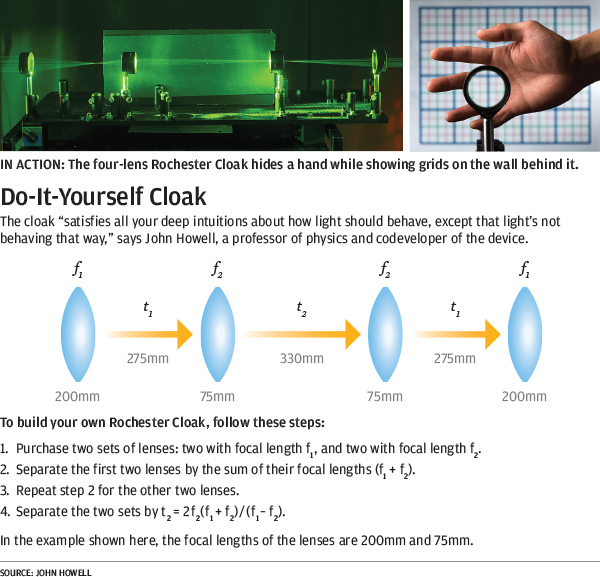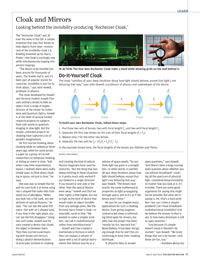In Review
 (Illustration: Steve Boerner/Photos: Adam Fenster)
(Illustration: Steve Boerner/Photos: Adam Fenster)The “Rochester Cloak” was all over the news in the fall. A simple invention that uses four lenses to hide objects from view—reminiscent of the invisibility cloak J. K. Rowling dreamed up for Harry Potter—the cloak is excitingly new while simultaneously tapping into ancient longings.
“The desire to be invisible has been around for thousands of years. The Greeks had it, and it’s been part of popular stories for centuries. Invisibility is just fun to think about,” says John Howell, professor of physics.
The cloak developed by Howell and doctoral student Joseph Choi uses ordinary lenses to hide an object from a range of angles. Director of the Center for Coherence and Quantum Optics, Howell is at the helm of several funded research projects on subjects from cold atoms to quantum imaging to slow light. But the simple, unfunded projects on cloaking have captured a lot of people’s imaginations.
He first started thinking about cloaking while on sabbatical three years ago, when he came across a paper by a group of Cornell researchers on temporal cloaking, or hiding an event in time. “And when I saw their experimental layout, I realized there were really simple ways to think about cloaking in space, not just in time,” he says.
One way was so simple that he and his sons built it at home using two L-shaped fish tanks they fashioned out of plexiglass. “When you look into a fish tank, you see all kinds of optical illusions,” he says. “You can see the same fish twice—but with an L-shaped tank, if you look in the right place, you can see the fish disappear.” Using two such tanks, Howell and his sons created a device that cloaks the object in between them. Then they started experimenting with lenses and mirrors, doing a playful demonstration of principles involved in cloaking and creating the kind of optical illusion magicians have used for centuries. “But the thing that was always limiting in those situations is, it pretty much only worked if you looked in a single direction. If you moved to one side or the other, then the optical illusion went away.” Howell and Choi set their sights a little higher, but not so high as the kind of device that would make an object invisible from any vantage point, like the fictional Harry Potter’s cloak—or wearable, come to that. “We wanted to solve a simpler problem—we call it multidirectional rather than omnidirectional.”
Howell and Choi created a mathematical formula in which they can replace a volume of space with a set of optical instruments that behave exactly as a volume of space would. “So you think light has gone in a straight line—in other words, it satisfies all your deep intuitions about how light should behave, except that light’s not behaving that way,” says Howell. “The lenses have exactly the same mathematical properties as light propagating through space, and so it’s as if the lenses aren’t there.”
He says he can imagine many applications for such a cloaking device, from giving surgeons unobstructed views to eliminating blind spots for drivers, but adds that the project has been “mostly for fun, low-tech fun.” Nevertheless, it has been intriguing enough that he and Choi are continuing to hone their cloaking technique.
“A physicist likes to answer open questions,” says Howell. “And there’s been a long-running open question about whether you can achieve broadband—covering all the spectrum of physical light—omnidirectional invisibility: no matter how you look at it, it’s invisible. There are some good arguments for saying that might not be possible. But what we’re saying is, OK, that’s a hard problem—but can I solve a simpler problem? Can I have broadband multidirectional invisibility? And we believe the answer to that is yes. In how many directions is still an open question.”
“Just because it’s simple doesn’t mean it shouldn’t be studied,” says Howell. “We study things that are a lot harder—and those are fun, too.”
—Kathleen McGarvey

